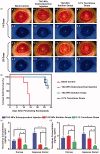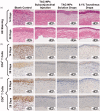Development and effects of tacrolimus-loaded nanoparticles on the inhibition of corneal allograft rejection
- PMID: 30895841
- PMCID: PMC6442111
- DOI: 10.1080/10717544.2019.1582728
Development and effects of tacrolimus-loaded nanoparticles on the inhibition of corneal allograft rejection
Abstract
Tacrolimus has been widely applied to prevent organ rejection after transplantation. However, the conventional pharmaceutical formulation of tacrolimus limits its applications in ocular therapy due to its hydrophobicity and low corneal penetrability. We optimized tacrolimus-loaded methoxy poly (ethylene glycol-block-poly (d, l)-lactic-co-glycolic acid) nanoparticles (TAC-NPs) by simple and effective nanotechnology as a drug delivery system for corneal graft rejection to overcome these drawbacks. The prepared TAC-NPs were 82.9 ± 1.3 nm in size, and the drug loading and encapsulation efficiency were 8.01 ± 0.23% and 80.10 ± 2.33%. Furthermore, New Zealand rabbits were used to analyze the single-dose pharmacokinetics of the TAC-NPs using high-performance liquid chromatography tandem mass spectrometry (HPLC-MS/MS). In rats with allogenic penetrating keratoplasty, the administration of TAC-NPs dispersion drops improved the TAC concentrations in the aqueous humor and cornea, consistent with a significantly higher effective inhibition of IL-2, IL-17, and VEGF expression compared with conventional 0.1% tacrolimus drops. Meanwhile, we also compared two different topical administration methods (including eye drop and subconjunctival injection) of TAC-NPs to maximize the sustained release characteristic of NPs. In summary, the small-sized TAC-NPs enhanced transcorneal permeation and absorption of TAC and more effectively inhibited corneal allograft rejection, which indicated that biodegradable polymeric nanomaterials-based drug delivery system had great potential for improving the clinical therapy efficacy of hydrophobic drugs.
Keywords: Tacrolimus; immune rejection; keratoplasty; mPEG-b-PLGA; nanoparticles.
Figures




Similar articles
-
Tacrolimus-loaded methoxy poly(ethylene glycol)-block-poly(D,L)-lactic-co-glycolic acid micelles self-assembled in aqueous solution for treating cornea immune rejection after allogenic penetrating keratoplasty in rats.Eur J Pharm Sci. 2019 May 15;133:104-114. doi: 10.1016/j.ejps.2019.03.023. Epub 2019 Mar 27. Eur J Pharm Sci. 2019. PMID: 30928512
-
Poly (d, l-lactide-co-glycolide) nanoparticles for sustained release of tacrolimus in rabbit eyes.Biomed Pharmacother. 2017 Oct;94:402-411. doi: 10.1016/j.biopha.2017.07.110. Epub 2017 Aug 1. Biomed Pharmacother. 2017. PMID: 28772219
-
Corticosteroid-loaded biodegradable nanoparticles for prevention of corneal allograft rejection in rats.J Control Release. 2015 Mar 10;201:32-40. doi: 10.1016/j.jconrel.2015.01.009. Epub 2015 Jan 8. J Control Release. 2015. PMID: 25576786 Free PMC article.
-
Advanced nanodelivery platforms for topical ophthalmic drug delivery.Drug Discov Today. 2021 Jun;26(6):1437-1449. doi: 10.1016/j.drudis.2021.02.027. Epub 2021 Mar 6. Drug Discov Today. 2021. PMID: 33689858 Review.
-
Biodegradable Nanoparticles: A Recent Approach and Applications.Curr Drug Targets. 2020;21(16):1722-1732. doi: 10.2174/1389450121666200916091659. Curr Drug Targets. 2020. PMID: 32938346 Review.
Cited by
-
Characterization and Evaluation of Rapamycin-Loaded Nano-Micelle Ophthalmic Solution.J Funct Biomater. 2023 Jan 16;14(1):49. doi: 10.3390/jfb14010049. J Funct Biomater. 2023. PMID: 36662096 Free PMC article.
-
Topical tacrolimus nanocapsules eye drops for therapeutic effect enhancement in both anterior and posterior ocular inflammation models.J Control Release. 2021 May 10;333:283-297. doi: 10.1016/j.jconrel.2021.03.035. Epub 2021 Mar 30. J Control Release. 2021. PMID: 33798665 Free PMC article.
-
Matrix-Assisted Laser Desorption and Electrospray Ionization Tandem Mass Spectrometry of Microbial and Synthetic Biodegradable Polymers.Polymers (Basel). 2023 May 18;15(10):2356. doi: 10.3390/polym15102356. Polymers (Basel). 2023. PMID: 37242931 Free PMC article. Review.
-
Use of Poly Lactic-co-glycolic Acid Nano and Micro Particles in the Delivery of Drugs Modulating Different Phases of Inflammation.Pharmaceutics. 2023 Jun 20;15(6):1772. doi: 10.3390/pharmaceutics15061772. Pharmaceutics. 2023. PMID: 37376219 Free PMC article. Review.
-
Clinical Efficacy of Topical Tacrolimus on Conjunctival Hyperemia Caused by Prostaglandin Analogues.Evid Based Complement Alternat Med. 2022 Oct 14;2022:3700720. doi: 10.1155/2022/3700720. eCollection 2022. Evid Based Complement Alternat Med. 2022. Retraction in: Evid Based Complement Alternat Med. 2023 Aug 16;2023:9795630. doi: 10.1155/2023/9795630. PMID: 36276850 Free PMC article. Retracted.
References
-
- Barbu E, Verestiuc L, Nevell TG, Tsibouklis J (2006). Polymeric materials for ophthalmic drug delivery: trends and perspectives. J Mater Chem 16:3439–43.
-
- Chen X, Chen J, Li B, et al. (2017). PLGA-PEG-PLGA triblock copolymeric micelles as oral drug delivery system: in vitro drug release and in vivo pharmacokinetics assessment. J Colloid Interf Sci 490:542–52. - PubMed
-
- Dickey JB, Cassidy EM, Bouchard CS (1993). Periocular FK-506 delays allograft rejection in rat penetrating keratoplasty. Cornea 12:204–7. - PubMed
-
- Duncan R, Gaspar R (2011). Nanomedicine(s) under the microscope. Mol Pharm 8:2101–41. - PubMed
MeSH terms
Substances
LinkOut - more resources
Full Text Sources
